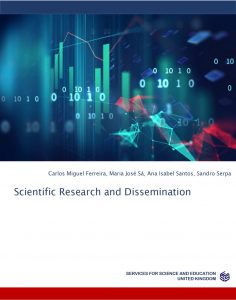Scientific Research and Dissemination
Carlos Miguel Ferreira
- ISCTE – University Institute of Lisbon, Portugal
- Keywords:
- Open Access, Digital Literacy, Research
- Abstract:
- By understanding reality in a rigorous and controlled way, scientific knowledge – always subject to discussion and, if necessary, reformulation – is critical to provide tools that may contribute to sustainable development. Scientific knowledge entails two critical dimensions: the process of conducting research and the dissemination of its product, which is materialised in the results obtained, which are at the base of this book. This publication presents, thus, a collection of some published articles as contributions to the analysis of vital elements present in social sciences in the contemporary world. Among these contributions, the following stand out: digital literacy; reading on scrolling text; writing in science; the internship report; argumentation, photography in research; interdisciplinarity; ethics and informed consent; scholarly publications and the role of both the academic editor and preprints; social media and online visibility; electronic slideshow presentations; and virtual and face-to-face academic conferences.
- Adams, C. A. (2010). Teachers building dwelling thinking with slideware. Indo-Pacific Journal of Phenomenology, 10(1), 1-12. https://doi.org/10.2989/ipjp.2010.10.1.3.1075
- Akbar, M. (2016). Digital technology shaping teaching practices in higher education. Frontiers in ICT, 3(1), 1-5. https://doi.org/10.3389/fict.2016.00001
- Alpert, F. (2016). Revitalizing the live lecture class with instructor-created videos. SAGE Open, 6(4), 1-12. https://doi.org/10.1177/2158244016680686
- Babb, K. A., & Ross, C. (2009). The timing of online lecture slide availability and its effect on attendance, participation, and exam performance. Computers & Education, 52(4), 868-881. https://doi.org/10.1016/j.compedu.2008.12.009
- Cadena, R. A., & Coutinho, S. G. (2017). Dez pontos sobre apresentações de slides, suas
- características e implicações para a prática docente. [Ten points about slideshow presentations, their characteristics, and implications for teaching practice]. Revista Principia – Divulgação Científica e Tecnológica do IFPB, 1(33), 58-66. https://doi.org/10.18265/1517-03062015v1n33p58-66
- Chou, P. N., Chang, C. C., & Lu, P. F. (2015). Prezi versus PowerPoint: The effects of varied digital presentation tools on students’ learning performance. Computers & Education, 91, 73-82. https://doi.org/10.1016/j.compedu.2015.10.020
- Flores-Hernández, F., & Villamar-Chulín, J. (2012). Elementos para el desarrollo de presentaciones académicas en PowerPoint. [Elements for the development of academic presentations in PowerPoint]. Investigación en Educación Médica, 1(3), 152-156.
- Garrett, N. (2016). How do academic disciplines use PowerPoint? Innovative Higher Education, 41(5), 365-380. https://doi.org/10.1007/s10755-016-9381-8
- Harris, D. (2011). Presentation software: Pedagogical constraints and potentials. Journal of Hospitality, Leisure, Sport and Tourism Education, 10(1), 72-84. https://doi.org/10.3794/johlste.101.339
- Hill, A., Arford, T., Lubitow, A., & Smollin, L. M. (2012). “I’m ambivalent about it”: The dilemmas of PowerPoint. Teaching Sociology, 40(3), 242-256. https://doi.org/10.1177/0092055×12444071
- Inoue-Smith, Y. (2015). Using PowerPoint effectively for classroom based lectures. The Journal of the World Universities Forum, 8(2), 9-19.
- Inoue-Smith, Y. (2016). College-based case studies in using PowerPoint effectively. Cogent Education, 3(1), 1-15, 1127745. https://doi.org/10.1080/2331186x.2015.1127745
- Kosslyn, S. M., Kievit, R. A., Russell, A. G., & Shephard, J. M. (2012). PowerPoint® presentation flaws and failures: a psychological analysis. Front. Psychology, 3(230), 1-22. https://doi.org/10.3389/fpsyg.2012.00230
- Moulton, S. T., Türkay, S., & Kosslyn, S. M. (2017). Does a presentation’s medium affect its message? PowerPoint, Prezi, and oral presentations. PLoS ONE, 12(7), 1-39. https://doi.org/10.1371/journal.pone.0178774
- Naik, N. (2017). Dual PowerPoint presentation approach for students with special educational needs and note-takers. European Journal of Special Needs Education, 32(1), 146-152. http://dx.doi.org/10.1080/08856257.2016.1254970
- Pros, R. C., & Tarrida, A. C. (2017). Percepción del aprendizaje, procedimientos de evaluación y uso de la tecnologia PowerPoint en la formación universitaria de Medicina. [Perception of learning, assessment procedures and the use of PowerPoint technology in University Studies of Medicine]. Intangible Capital, 13(2), 302-318. http://dx.doi.org/10.3926/ic.814
- Savoy, A., Proctor, R. W., & Salvendy, G. (2009). Information retention from PowerPoint and traditional lectures. Computers & Education, 52(4), 858-867. http://dx.doi.org/10.1016/j.compedu.2008.12.005
- Schoeman, S. (2013). Presentation technology as a mediator of learners’ retention and comprehension in a History classroom. Yesterday & Today, 9, 67-90.
- Tejada-Llacsa, P. J., & Cahuana-Aparco, J. (2016). Uso de PowerPoint en clases: ¿es necesario estudiarlo? [Using PowerPoint in class: Is it necessary to study it?]. Rev Med Chile, 144(5), 682-683 (Cartas al Editor / Letters to the Editor). http://dx.doi.org/10.4067/S0034-98872016000500021
- Wharton, C. Y, Goodwin, L. J., & Cameron, A. J. (2014). Living up to our students’ expectations – using student voice to influence the way academics think about their undergraduates learning and their own teaching. International Journal of Higher Education, 3(4), 72-84. https://doi.org/10.5430/ijhe.v3n4p72
- Worthington, D. L., & Levasseur, D. G. (2015). To provide or not to provide course PowerPoint® slides? The impact of instructor-provided slides upon student attendance and performance. Computers & Education, 85, 14-22. https://doi.org/10.1016/j.compedu.2015.02.002

Published
- November 1, 2020
Categories
Copyright
- Copyright (c) 2020 Carlos Miguel Ferreira
License
This work is licensed under a Creative Commons Attribution 4.0 International License.